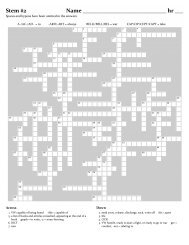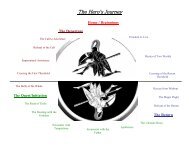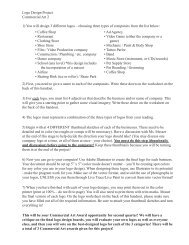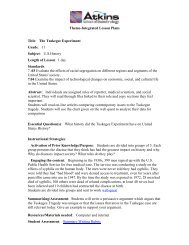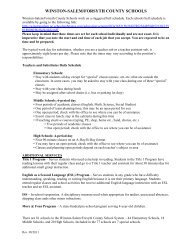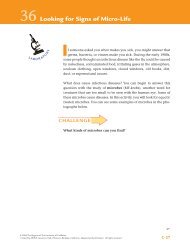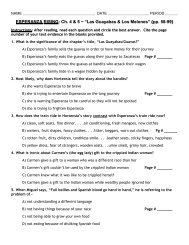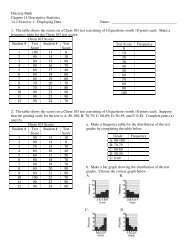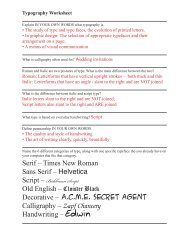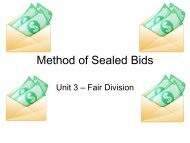You also want an ePaper? Increase the reach of your titles
YUMPU automatically turns print PDFs into web optimized ePapers that Google loves.
Identify the content areas you have not studied.If unfamiliar content areas make up major portions of thetests, consider taking coursework to help you gainknowledge and skills in these areas before you take the<strong>ACT</strong>. Because the <strong>ACT</strong> measures knowledge and skillsacquired over a period of time, it is unlikely that a “cram”course covering material that is unfamiliar to you will helpyou improve your scores. Longer-term survey courses willbe most helpful to you, because they aim to improve yourknowledge through sustained learning and practice.<strong>ACT</strong> English <strong>Test</strong>The English <strong>Test</strong> is a 75-question, 45-minute test thatmeasures your understanding of the conventions ofstandard written English (punctuation, grammar andusage, and sentence structure) and of rhetorical skills(strategy, organization, and style). Spelling, vocabulary,and rote recall of rules of grammar are not tested. The testconsists of five essays, or passages, each of which isaccompanied by a sequence of multiple-choice testquestions. Different passage types are employed toprovide a variety of rhetorical situations. Passages arechosen not only for their appropriateness in assessingwriting skills but also to reflect students’ interests andexperiences.Some questions refer to underlined portions of the passageand offer several alternatives to the portion underlined. Youmust decide which choice is most appropriate in thecontext of the passage. Some questions ask about anunderlined portion, a section of the passage, or thepassage as a whole. You must decide which choice bestanswers the question posed. Many questions offer “NOCHANGE” to the passage as one of the choices. Thequestions are numbered consecutively. Each questionnumber refers to a correspondingly numbered portionunderlined in the passage or to a corresponding numeralin a box located at the appropriate point in the passage.Three scores are reported for the <strong>ACT</strong> English <strong>Test</strong>: a totaltest score based on all 75 questions, a subscore inUsage/Mechanics based on 40 questions, and a subscorein Rhetorical Skills based on 35 questions.Tips for Taking the <strong>ACT</strong> English <strong>Test</strong>Pace yourself.The <strong>ACT</strong> English <strong>Test</strong> contains 75 questions to becompleted in 45 minutes. If you spend 1 1 ⁄2 minutesskimming through each passage before responding to thequestions, then you will have 30 seconds to answer eachquestion. If possible, spend less time on each questionand use the remaining time allowed for this test to reviewyour work and return to the questions on this test that weremost difficult for you.Be aware of the writing style used in each passage.The five passages cover a variety of topics and are writtenin a variety of styles. It is important that you take intoaccount the writing style used in each passage when yourespond to the questions. In responding to a question, besure to understand the context of the question. Considerhow the sentence containing an underlined portion fits in<strong>with</strong> the surrounding sentences and into the passage as awhole.Examine the underlined portions of the passage.Before responding to a question <strong>with</strong> an underlinedportion, carefully examine what is underlined in the text.Consider the elements of writing that are included in eachunderlined portion. Some questions will ask you to baseyour decision on some specific element of writing, such asthe tone or emphasis the text should convey. Somequestions will ask you to choose the alternative to theunderlined portion that is NOT or LEAST acceptable. Theanswer choices for each question will contain changes inone or more of those elements of writing.Be aware of questions <strong>with</strong> no underlined portions.You will be asked some questions about a section of thepassage or about the passage as a whole, in light of agiven rhetorical situation. Questions of this type are oftenidentified by a question number in a box located at theappropriate point in the passage. Questions asking globalquestions about the entire passage are placed at the endof the passage and introduced by a horizontal boxenclosing the following instruction: “Questions ___ and ___ask about the preceding passage as a whole.”Note the differences in the answer choices.Many of the questions in the test will involve more than oneaspect of writing. Examine each answer choice and how itdiffers from the others. Be careful not to select an answerthat corrects one error but causes a different error.Determine the best answer.Two approaches can be taken to determine the best answerto a question in which you are to choose the best alternativeto an underlined portion. In the first approach, you canreread the sentence or sentences, substituting each of thepossible answer choices for the underlined portion todetermine the best choice. In the second approach, you candecide how the underlined portion might best be phrased instandard written English or in terms of the particular questionposed. If you think the underlined portion is the best answer,you should select “NO CHANGE.” If not, you should checkto see whether your phrasing is one of the other answerchoices. If you do not find your phrasing, you should choosethe best of the answers presented. For questions cued by anumber in a box, you must decide which choice is mostappropriate in terms of the question posed or the statedrhetorical situation.Reread the sentence, using your selected answer.Once you have selected the answer you feel is best,reread the corresponding sentence(s) of the passage,inserting your selected answer at the appropriate place inthe text to make sure it is the best answer <strong>with</strong>in thecontext of the passage.Content Covered by the <strong>ACT</strong> English <strong>Test</strong>Six elements of effective writing are included in the English<strong>Test</strong>: punctuation, grammar and usage, sentence structure,strategy, organization, and style. The questions coveringpunctuation, grammar and usage, and sentence structuremake up the Usage/Mechanics subscore. The questionscovering strategy, organization, and style make up theRhetorical Skills subscore. A brief description and theapproximate percentage of the test devoted to eachelement of effective writing are given on the next page.6



